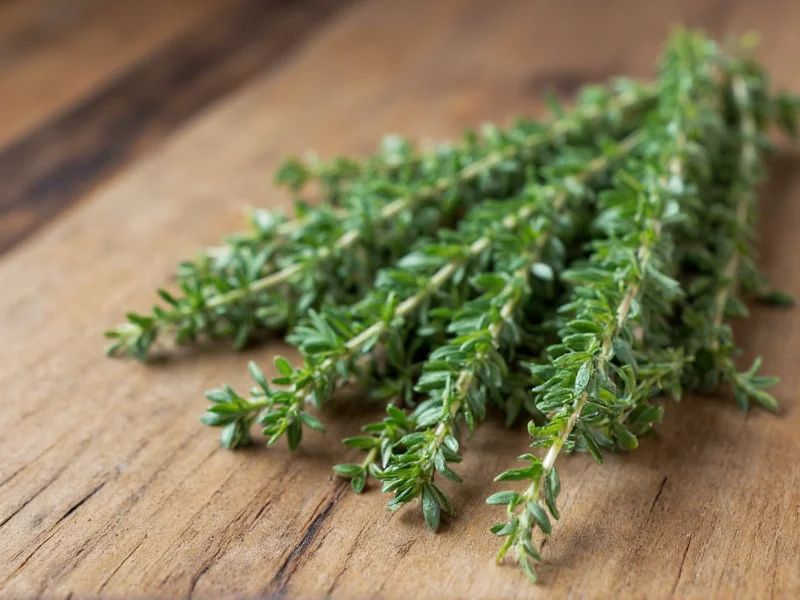Understanding thyme measurements is essential for perfect seasoning in your recipes. When substituting dried thyme for fresh sprigs, you need to account for the significant difference in flavor concentration that occurs during the drying process. This comprehensive guide provides accurate conversion ratios, practical cooking tips, and valuable insights to help you master thyme measurements in any recipe.
Why Fresh and Dried Thyme Measurements Differ
Thyme loses moisture during the drying process, concentrating its essential oils and flavor compounds. Fresh thyme contains about 80-90% water, while dried thyme has only 5-10% moisture content. This dramatic reduction explains why you need less dried thyme to achieve equivalent flavor.
The standard culinary conversion ratio is 3:1 for most herbs, but thyme follows a slightly different 2:1 ratio due to its unique leaf structure and oil composition. Each small thyme sprig (about 2-3 inches long with leaves) contains roughly the same flavor compounds as ¼-½ teaspoon of dried thyme, depending on the plant's maturity and growing conditions.
Complete Thyme Measurement Conversion Chart
| Fresh Thyme | Dried Thyme Equivalent | Best For |
|---|---|---|
| 1 small sprig (2-3") | ¼-½ teaspoon | Delicate sauces, finishing dishes |
| 3-4 small sprigs | 1 teaspoon | Standard recipe conversion |
| 1 large sprig (4-5") | ¾-1 teaspoon | Robust dishes, stews, braises |
| 1 tablespoon fresh leaves | 1 teaspoon | Precise measurement situations |
| 1 cup packed fresh | 3 tablespoons | Large batch cooking |
Practical Conversion Guidelines for Home Cooks
When converting thyme sprig to dried measurements in your recipes, consider these important factors that affect the thyme sprig to dried conversion ratio:
Account for Thyme Variety
Common thyme (Thymus vulgaris) follows the standard conversion, but specialty varieties like lemon thyme or caraway thyme may have slightly different potency. English thyme typically requires the full 2:1 ratio, while more delicate varieties might need a 1.5:1 ratio.
Recipe Type Matters
For thyme substitution in recipes involving long cooking times (stews, braises), use the lower end of the conversion range (¼ teaspoon dried per sprig). For quick-cooking dishes or finishing applications, use the higher end (½ teaspoon). The extended cooking time allows dried thyme's flavors to fully develop.
Leaf Density Variations
Thyme sprigs vary in leaf density. A sprig with abundant leaves contains more flavor than a sparse one. When precision matters, strip the leaves from sprigs and measure them before converting to dried equivalents. This approach gives the most accurate fresh thyme to dried thyme measurement.
Professional Cooking Tips for Using Dried Thyme
Master chefs recommend these techniques when working with dried thyme equivalent to fresh thyme:
- Add dried thyme early: Unlike fresh thyme, which can be added toward the end of cooking, dried thyme benefits from longer exposure to heat. Add it during the sauté phase to allow flavors to bloom.
- Rehydrate for immediate use: For dishes with short cooking times, mix dried thyme with a small amount of warm water or broth 10-15 minutes before adding to your recipe. This mimics fresh thyme's moisture content.
- Store properly: Keep dried thyme in an airtight container away from light and heat. Properly stored, it maintains peak flavor for 6-12 months. Older thyme requires slightly more quantity for equivalent flavor.
- Crush between fingers: Before adding dried thyme to recipes, rub the leaves between your fingers to release essential oils and enhance flavor distribution.
Common Thyme Conversion Mistakes to Avoid
Many home cooks make these errors when attempting cooking with dried thyme instead of fresh:
- Using equal measurements: Never substitute 1:1. Dried thyme is significantly more potent, and equal measurements will result in overpowering, bitter flavors.
- Ignoring recipe context: A soup that simmers for hours needs less dried thyme than a quick sauté where flavors don't have time to mellow.
- Not adjusting for thyme age: Older dried thyme loses potency. If your container is more than 6 months old, increase the amount by 25-50%.
- Measuring sprigs inconsistently: A "sprig" isn't a standardized measurement. Always specify small (2-3") or large (4-5") sprigs when sharing recipes.
When to Stick with Fresh Thyme
While understanding how much dried thyme equals one sprig is valuable, some dishes truly benefit from fresh thyme's brighter, more complex flavor profile:
- Raw applications like salad dressings and compound butters
- Finishing dishes where fresh herbal notes shine
- Delicate fish preparations
- Summer dishes where fresh flavors are preferred
For the most authentic Mediterranean flavors in dishes like ratatouille, bouillabaisse, or roasted vegetables, fresh thyme generally provides superior results when available.











 浙公网安备
33010002000092号
浙公网安备
33010002000092号 浙B2-20120091-4
浙B2-20120091-4